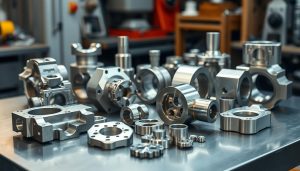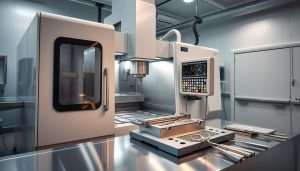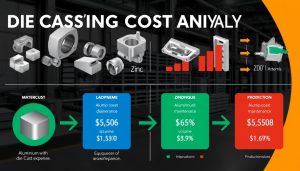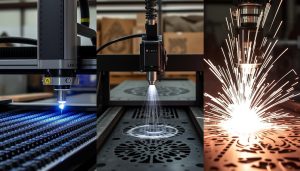When it comes to metal finishing, powder coating and anodizing are two of the most popular techniques. Both methods offer distinct advantages and are widely used across various industries. In this article, we’ll delve into the intricacies of powder coating and anodizing, exploring their processes, benefits, and applications to help you determine which approach is the best fit for your project.
What is Powder Coating?
Powder coating is a dry finishing process that has become increasingly popular in recent years. This innovative technique involves the application of electrostatically charged powder onto a surface, followed by a curing process under heat. The result is a durable, electrostatic spray deposition that provides a uniform, durable finish to a wide range of products.
The Process of Powder Coating
The powder coating process begins with the surface being thoroughly cleaned and prepared. The powder is then electrostatically charged and sprayed onto the target surface. As the powder particles make contact, they adhere to the surface due to the electrostatic charge. Finally, the coated item is placed in a curing oven, where the curing process takes place, fusing the powder coating to the surface and creating a robust, long-lasting finish.
Advantages of Powder Coating
- Exceptional durability and resistance to wear, chipping, and fading
- Wide range of color options and finish types, from glossy to matte
- Environmentally friendly, as powder coating is solvent-free and produces minimal waste
- Cost-effective, with lower material and labor costs compared to traditional finishing methods
Common Applications of Powder Coating
Powder coating has found widespread use across various industries, including:
- Automotive components (e.g., wheels, trim, and fasteners)
- Household appliances and fixtures
- Outdoor furniture and equipment
- Architectural elements (e.g., window frames, railings, and facades)
- Industrial machinery and equipment
“Powder coating provides a durable, uniform, and visually appealing finish that can withstand the elements and heavy use, making it a popular choice for a wide range of applications.”
What is Anodizing?
Anodizing is an electrochemical process that creates a durable, porous oxide layer on metal surfaces, particularly aluminum. This innovative technique enhances the corrosion resistance of the underlying metal, making it a popular choice for a wide range of applications.
The Process of Anodizing
The anodizing process involves immersing the metal part in an acid bath and running an electric current through it. This process causes the metal to oxidize, forming a protective oxide layer on the surface. The thickness and properties of this layer can be controlled by adjusting the duration and electrical current of the process.
Advantages of Anodizing
- Improved corrosion resistance for enhanced durability
- Increased hardness and abrasion resistance
- Ability to create a wide range of colors and finishes
- Enhanced adhesion for paints, inks, and other coatings
Common Applications of Anodizing
Anodized finishes are widely used in a variety of industries, including:
- Aerospace and defense: Aircraft components, satellite parts, and military equipment
- Architecture and construction: Architectural panels, window frames, and door hardware
- Consumer electronics: Smartphones, laptops, and tablets
- Automotive: Wheels, trim, and engine components
The electrochemical process of anodizing creates a durable oxide layer that enhances the corrosion resistance of the underlying metal, making it a versatile and valuable surface finishing technique for a wide range of applications.

Key Differences Between Powder Coating and Anodizing
When it comes to surface finishing, both powder coating and anodizing offer unique advantages. However, understanding the key differences between these two techniques can help you make an informed decision for your project. Let’s explore the areas of durability, aesthetic qualities, and cost comparison.
Durability: Wear Resistance vs. Chemical Resistance
Powder coating excels in wear resistance, making it a durable choice for high-traffic areas and applications that require a tough, scratch-resistant finish. Anodizing, on the other hand, is renowned for its chemical resistance, providing excellent protection against corrosion and environmental factors.
Aesthetic Qualities: Color Options and Finish Types
Powder coating offers a wide array of color options and finish types, allowing for greater aesthetic versatility. From matte to glossy, and a rainbow of color choices, powder coating can transform the visual appeal of your project. Anodizing, while providing a sleek, metallic look, typically has a more limited color palette.
Cost Comparison: Powder Coating vs. Anodizing
| Feature | Powder Coating | Anodizing |
|---|---|---|
| Cost | Generally lower | Generally higher |
| Setup Costs | Relatively lower | Relatively higher |
| Maintenance | Minimal | Moderate |
Powder coating typically has a lower overall cost compared to anodizing, with more affordable setup and maintenance requirements. This can make it a more budget-friendly option for some projects.

“Understanding the key differences between powder coating and anodizing can help you make an informed decision for your project.”
Which Finish is Best for Your Project?
When it comes to selecting the right surface finishing method for your project, several key factors need to be considered. The choice between powder coating and anodizing ultimately depends on the specific requirements of your project, including the base material, intended application, and environmental conditions.
Material Compatibility
The base material of your project is a crucial factor in determining the most suitable finishing technique. Powder coating is compatible with a wide range of materials, including metals, plastics, and even some woods. Anodizing, on the other hand, is primarily used for aluminum and its alloys, as it enhances the natural oxide layer on the surface.
Application and Environment
The intended application and environmental conditions of your project also play a significant role in the selection process. Powder coating excels in providing excellent wear resistance and durability, making it a top choice for projects that will be exposed to frequent physical contact or abrasion. Anodizing, conversely, offers superior chemical resistance, making it the preferred option for applications in harsh environments or where exposure to corrosive elements is a concern.
| Factor | Powder Coating | Anodizing |
|---|---|---|
| Material Compatibility | Metals, plastics, woods | Aluminum and its alloys |
| Wear Resistance | Excellent | Good |
| Chemical Resistance | Good | Excellent |
| Harsh Environments | Suitable | Highly Suitable |
By carefully considering the project requirements, environmental conditions, and material compatibility, you can make an informed decision on the most appropriate surface finishing method for your project.
Shixinproto’s Surface Finishing Services
At Shixinproto, we are dedicated to providing our clients with top-notch surface finishing solutions tailored to their specific needs. Our team of experts specializes in delivering custom powder coating and anodizing services that meet industry standards and exceed expectations.
Professional Powder Coating and Anodizing Solutions for Your Business
Whether you’re looking to enhance the durability, appearance, or corrosion resistance of your products, Shixinproto has the expertise and capabilities to deliver. Our state-of-the-art facilities and cutting-edge technologies ensure that every project we undertake results in a high-quality, long-lasting finish. From custom color matching to precise application techniques, we work closely with our clients to create custom finishing solutions that meet their unique requirements.
At Shixinproto, we take pride in our commitment to quality surface treatments. Our team of skilled professionals meticulously adheres to industry best practices, ensuring a flawless finish every time. With a proven track record of delivering exceptional results, we have become a trusted partner for businesses across a wide range of industries, from automotive to aerospace and beyond.





